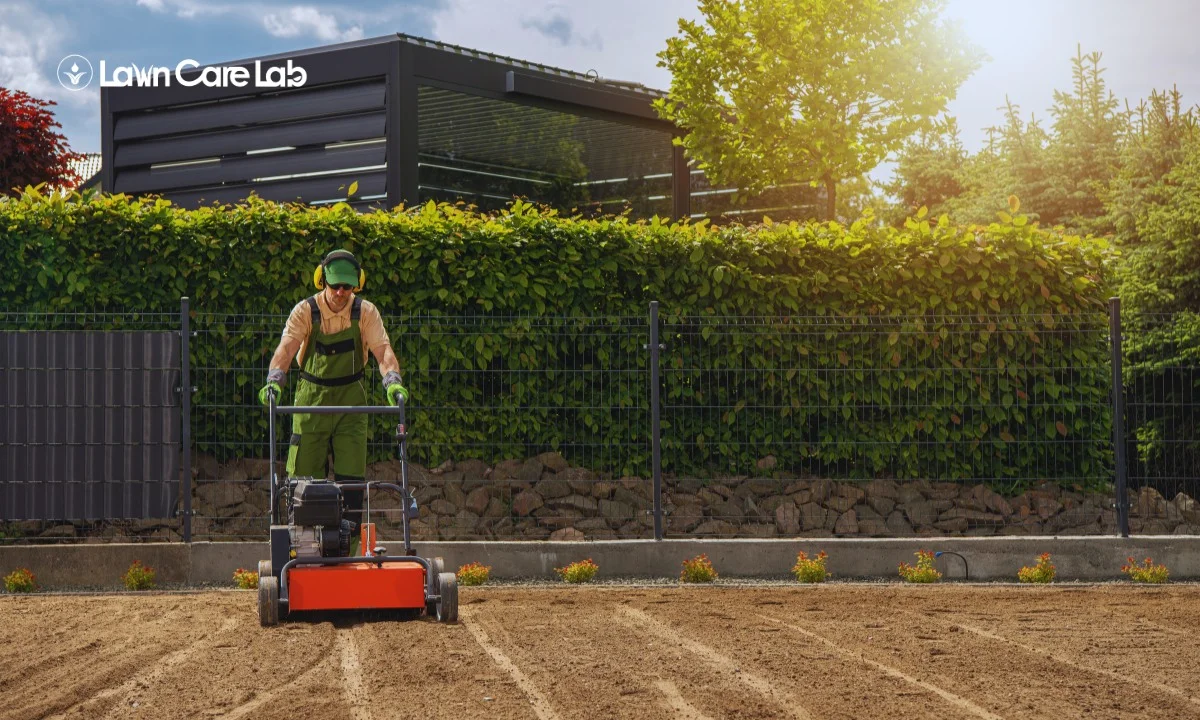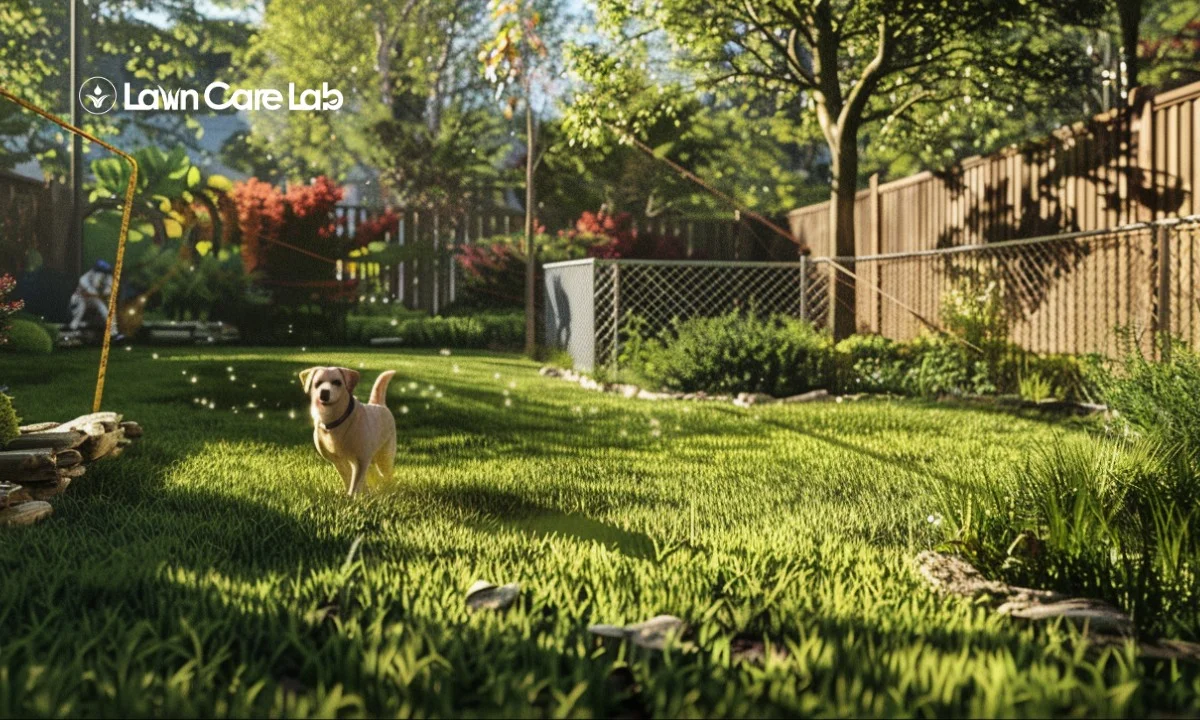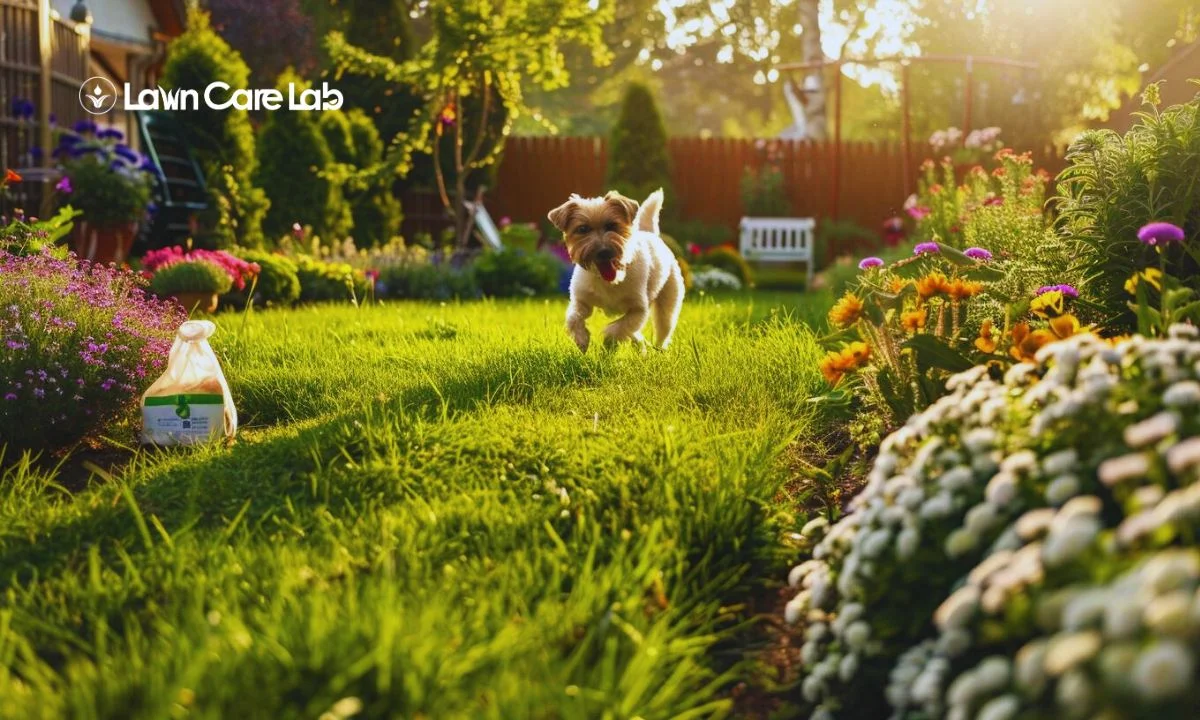Dreary winter lawns: We feel your pain.
Achieve a green lawn this spring by incorporating aeration and overseeding. Penetrating the soil and thickening the grass will make your lawn look vibrant.
Aeration alleviates soil compaction while overseeding improves turf density – together, they enable strong grass growth before summer stress sets in.
So, let’s explore the techniques of spring aeration and overseeding for a desirable lawn!
Table of Contents
Understanding Aeration and Overseeding
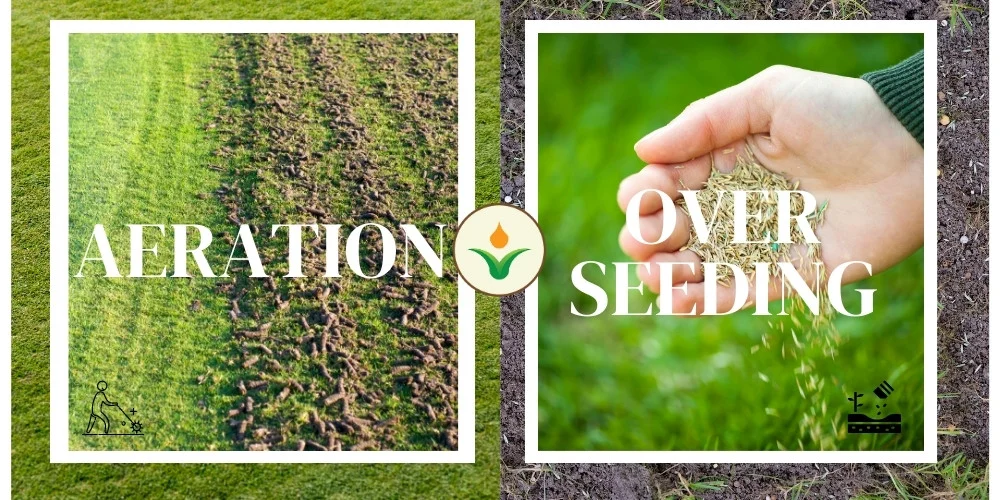
We’re about to explore two important lawn care practices: Aeration and Overseeding.
Aeration involves making small holes in your lawn to let air, water, and nutrients reach the grass roots more effectively.
Next, we’ll look at overseeding, which involves adding new grass seeds to sparse or patchy areas, making your lawn denser and healthier.
The Process of Aeration
Aeration is a process where a core aerator takes out soil plugs. This creates holes for air, water, and nutrients to reach the grassroots. It’s a good way to fix soil compaction and improve soil health.
It’s also crucial for a healthy, green lawn in spring because it supports deep root growth.
Safety matters during aeration. Make sure to wear strong shoes and gloves. Before you start, check your yard for any hidden objects or dangers.
Knowing these safety steps and understanding aeration will help you succeed in gardening.
The Role of Overseeding
Overseeding is a process that improves your lawn’s look and health by introducing new grass seeds. This method increases the grass density and helps control weeds. It’s most effective when paired with aeration, which ensures direct contact between the seed and soil. This helps the new seeds take root quickly.
Overseeding does more than just enhance your lawn’s beauty by filling in sparse areas. It also boosts the overall health of the grass. The thick growth makes it difficult for diseases and pests to thrive. Additionally, it reduces the need for chemical weed killers, making your lawn safer for your family and pets.
Consider trying overseeding for a healthier, more attractive lawn.
Timing Spring Lawn Aeration Correctly
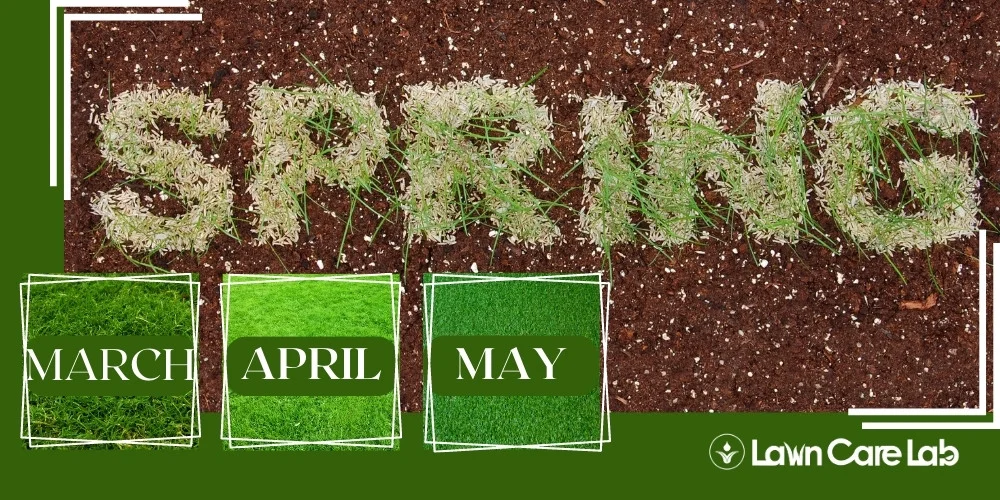
When preparing your lawn for spring, don’t forget to aerate it at the start of the season. Try to finish this job between the end of March and the middle of April, which is perfect for most weather conditions.
Avoid aerating too late, as it can expose your lawn to heat and lack of water, harming the grass while recovering.
Aerate Early in the Spring Season
Aerating your lawn early in spring allows it to recover before the summer heat. This improves your lawn’s health by preparing it for hot and dry conditions. Here’s why you should aerate in spring:
- You can make the most of spring rains. They naturally water newly seeded areas, promoting healthier growth.
- Core aeration is best when soil temperatures are 55-60°F. This creates the best conditions for root growth.
- Your lawn gets the recovery time it needs before the intense summer heat.
Don’t forget, it’s important to be safe when using an aerator. Wear the right safety gear and follow the instructions provided by the manufacturer.
Target Late March to Mid-April
Let’s discuss the best time for lawn aeration and overseeding in cooler regions. Aim for late March to mid-April. This timing is perfect as it provides the right conditions for these activities before it gets too hot.
| Best Time | Reason |
|---|---|
| Late March | The soil starts to thaw. This makes it easy for the aerator to penetrate and gives seeds the needed nutrients. |
| Mid-April | The temperature remains cool so that the seeds can germinate without heat damage. |
This plan helps you nurture a healthy lawn that can withstand severe weather. The result is a beautiful green lawn, making your outdoor space a peaceful and attractive place all year round.
Aeration Too Late Risks Heat/Drought Stress
Neglecting timely lawn care can lead to severe damage from the summer’s heat and drought. Aeration timing is key; it involves more than punching lawn holes. If done late in spring, grass may not be established properly before increased foot traffic. Overseeding may fail if it starts less than a month before the temperature spike. Additionally, heat and drought might burn young grass and dry out.
Strive for balance. Don’t delay until it’s extremely hot or dry, but don’t start while frost remains. This ensures your lawn is protected from unnecessary harm.
Now we’ll discuss ‘overseeding after spring aeration.’
Overseeding After Spring Aeration
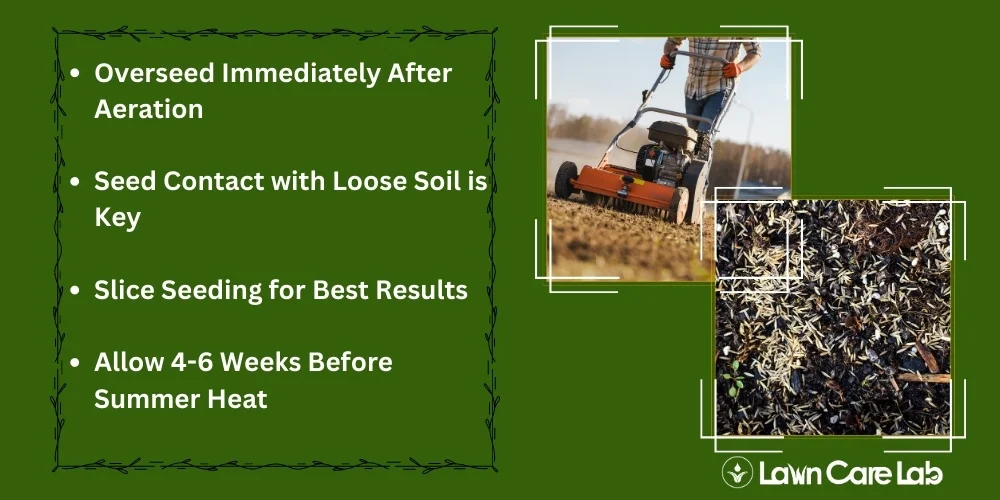
Overseed your lawn right after aeration. This allows the seeds to touch the loose soil.
Slice seeding is usually the best way because it ensures the seeds connect well with the soil for good growth.
Plan this task well, and do it 4-6 weeks before the hot summer weather for the best outcome.
Overseed Immediately After Aeration
After aerating your lawn, overseed immediately. The timing is crucial for better seed-to-soil contact, encouraging faster germination. The newly loosened soil and open environment are ideal for seeding.
Placing seeds into aeration holes ensures they go directly into the ground, not just on the surface. The aerated soil makes it easier for the roots of seedlings to grow and establish. Overseeding right after aeration can help prevent weeds, resulting in a healthier lawn.
Always prioritize safety. Wear protective gear when spreading seeds, and avoid stepping on freshly seeded patches.
With careful planning and execution, a lush green lawn is achievable.
Seed Contact with Loose Soil is Key
Direct contact between seeds and loose soil is essential for growth. Aerate your lawn in spring to loosen the soil and create ideal conditions for overseeding. Aeration holes let seeds settle into the ground and grow strong roots. This leads to a rich green lawn over time.
Always wear gardening gloves and shoes for safety. Excellent seed-to-soil contact is crucial for a healthy lawn. A well-aerated lawn improves seed spread and grass growth.
Now, let’s discuss slice seeding for optimal results.
Slice Seeding for Best Results
When striving for a thriving garden, slice seeding is your best approach. This technique positions seeds at the ideal depth for sprouting, reducing the risk of being washed away or eaten by birds.
Slice seeding involves making light incisions in the soil, an excellent step after aeration. These incisions provide a safe and favorable environment for the seeds to grow. This method enhances the contact between the seed and soil, which is crucial for successful overseeding.
Now, let’s talk about timing. Make sure to wait for 4-6 weeks before the peak of summer.
Allow 4-6 Weeks Before Summer Heat
Ensure your new grass gets around 4-6 weeks to establish deep roots before summer. This timeframe helps develop a robust root system capable of enduring severe weather. Here’s a simplified guide:
| Weeks After Overseeding | Progress | Benefits |
|---|---|---|
| 1-2 Weeks | Start of Germination | Initial establishment |
| 3-4 Weeks | Increase in Grass Height | Protection against weeds |
| 5-6 Weeks | Development of Deep Roots | Resistance to heat and drought |
Safety is crucial in maintaining your lawn. Allowing new grass sufficient growth time lowers the risk of a frail lawn prone to disease or pests. You may ask: Can it be aerated and overseed in the spring?
Want to do Aeration and Overseeding in Spring?
Are you thinking about aerating and overseeding your lawn this spring? This is a great idea because these two methods can greatly improve your lawn.
We will discuss the specific benefits of aeration and overseeding. This will give you a thorough understanding and useful advice to boost the health and look of your lawn.
Benefits of Aerating and Overseeding Together
Aerating and overseeding together provide an unbeatable way to prepare your lawn for the summer. This pair greatly enhances your grass’s color while making it a secure and lush play area for your family.
Let’s look at some of the specific advantages:
- Enhanced soil composition: Aeration helps break down dense soil, giving roots an easier path to water, nutrients, and oxygen. This leads to healthier, more robust grass.
- Increased grass thickness: Overseeding helps cover thin or empty patches in your lawn, resulting in a dense green layer that’s more resistant to weeds and disease.
- Direct seed-to-soil contact: The holes made by aeration are ideal for seeds, eliminating the need for extra effort.
As you can see, this effective combination offers both safety and aesthetic benefits!
Spring Aeration Preparation
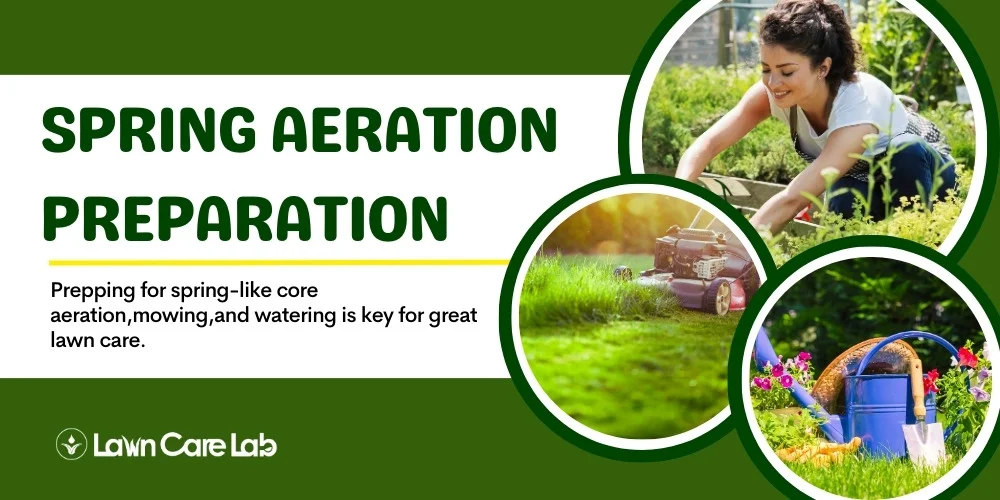
Prepping for spring aeration is key for great lawn care.
Start with core aeration, removing small soil parts from your lawn. This cuts down compaction and lets nutrients reach the roots.
Before you start, mow your lawn short to make aeration more effective.
After aeration and seeding, water your lawn well. This gives seeds the hydration they need to grow well.
Core Aeration for Best Results
Core aeration leads to a vibrant, green lawn come springtime. This method involves pulling out soil plugs for better soil penetration. It breathes new life into your lawn and lets air, water, and nutrients reach deep into the grass.
Here’s why core aeration is good for your lawn:
- Better Soil Penetration: This method reduces soil compaction, promoting deep root growth for sturdy grass.
- Enhanced Air Flow: Core aeration opens channels, improving oxygen circulation for healthy plants.
- Improved Nutrient Absorption: Nutrients reach the roots easily and absorb more effectively.
Before you start, remember to prioritize safety! Always wear protective gear while aerating your lawn.
Mow Lawn Short Pre-Aeration
Mow your lawn short before starting the core aeration process. This step is crucial for better soil penetration. The lawn should be about 1-2 inches high. This allows the aerator’s tines to penetrate, breaking up compacted soil. Short grass helps the tines work more effectively.
This process is beneficial for the roots. It improves the exchange of air between the soil and the atmosphere. It also enhances water absorption and nutrient uptake, resulting in a green lawn in spring.
Water Thoroughly After Aeration/Seeding
After aeration and seeding, it’s crucial to water your lawn properly. This promotes seed germination and prevents stress on the newly aerated turf.
Here are some tips for effective watering:
- Deep watering is better than frequent watering. It helps seeds reach deeper soil layers.
- Don’t water your lawn at night. This can lead to diseases due to excessive moisture.
- Keep up with a regular watering schedule until the new grass is mature.
Conclusion
You’ve successfully navigated through the complexities of aeration and overseeding. You could almost start a lawn care service!
Keep in mind timing is key. Spring is your best opportunity for a vibrant green lawn. So, get your aerator, spread those seeds, and let nature take its course.
Your lawn will be the talk of the neighborhood. Get ready for a beautiful lawn!
FAQs on Aeration and Overseeding
Is it advisable to aerate lawns during the spring?
Which type of grass is best for overseeding in spring?
What steps should be taken before aeration and overseeding?
How crucial is aeration in spring?
Could you explain the method of lawn aeration?
Can you define overseeding?
Could you list the five types of aeration?
How does aeration differ from overseeding?
When is the most suitable time to aerate a lawn?
- How to Create a Lawn Care Schedule for Southern Climates - October 30, 2024
- How to Use Compost Tea to Boost Lawn Growth and Soil Health - October 23, 2024
- The Best Grasses for Saltwater-Exposed Lawns: Coastal Lawn Care - October 17, 2024

